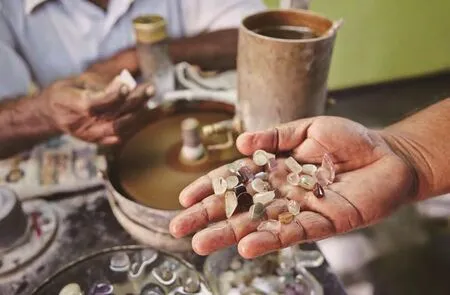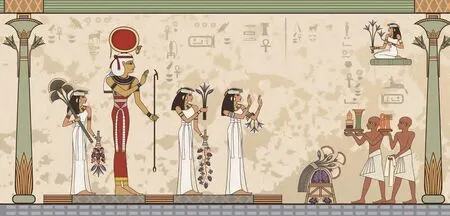Bargaining in Sri Lanka
By Chen Shupei
Bargaining is a natural part of shopping. When a Chinese person tries to buy something in a foreign country, bargaining becomes a necessary skill, especially when buying precious jewels. As a journalist working in Sri Lanka,I found it was a funny thing to bargain with a local jeweler.
In Sri Lanka, you are allowed to bargain at any jewelry store,be it a state-owned store or a privately-owned one. However the ratio of price reduction can be much different. For example, the price tag of a onecarat opal with medium quality may be over 1,000 US dollars at a store in a five-star hotel;and if you walk into a privatelyowned store, you may be asked to pay only several hundred for virtually the same gem.Moreover, the final price is often half the original offer.
In Colombo there is a privately-owned jewelry store named “Kupala” frequented by many Chinese customers. The aged owner recently handed the store down to his son-in-law,whom the Chinese customers nicknamed “Little Boss.”
Little Boss is an artful owner.He has done all he can to attract Chinese buyers. For example, he implies his “close relationship”with the Chinese Embassy by fixing on the wall of his store an enlarged photo of a wellknown leader of China visiting the place. That trick certainly works. Most Chinese buyers are likely to visit his store. If he thinks you are a potential buyer, he will invite you to a small room behind the store and show you gemstones of all types of resplendent colors. Ruby,sapphire, opal, amethyst, topaz,iolite… are all waiting there for your selection.
I once visited the store with a friend. When my friend took a fancy to a ruby, Little Boss asked him for 16,000 rupees(about 400 US dollars by the time). Our counteroffer was half the price, but the boss would not accept it. After a lot of hard bargaining, we agreed to pay 9,000 rupees, while the boss insisted on a price of 10,000.The transaction price was ultimately a little bit higher than half the asking price.
At the Khan al-Khalili market in Egypt, there was even more space for price reduction. I heard a story about a Chinese student buying gems at a store there.The owner said hello to him in Japanese, and when the student responded in Japanese without thinking, the boss demanded an exorbitant price from him.

买东西要砍价,天经地义,在国外也一样,买宝石尤其如此。我在斯里兰卡工作期间,耳闻目睹或亲身经历,觉得同宝石商砍价很好玩。
在斯里兰卡,无论国有店还是私营店,都能砍价。一颗一克拉的中等质量的猫眼石,五星级饭店附属的宝石店开价可能高达上千美元,一般的私营店也就几百美元。最后成交价常常是拦腰砍掉一半。
科伦坡高尔路上有家私营宝石店,叫“库帕拉”,是中国人常常光顾的。商店的老板上了年纪,生意交给他的女婿经营。中国来客管这位女婿叫小老板。

小老板心眼活,会来事,为招揽中国人的生意,动了很多脑筋。他拼命同中国大使馆拉关系,把一位中国名人的照片放大后挂在店堂中,以示同中国人关系很铁。
凡是到斯里兰卡的中国人,想买宝石多半都到这家宝石店去。如果看你真心想买,小老板就把你请到店堂后面的小屋里,拿出五光十色的宝石让你挑。红宝石、蓝宝石、猫眼、紫金、黄玉、星光等一溜儿摆着,让你挑个够。
有一次,我陪一位朋友去买宝石。朋友选中一颗红宝石,问小老板多少钱。他开价16000卢比,约合400美元。我们还价一半,小老板不干,几经讨价还价,最后我们还到9000卢比,小老板仍坚持非一万不卖。
这下我们心中有数了。这家店的实际成交价,基本上是开价的一半多一点儿。
在埃及的工艺品市场“哈利利”,砍价更邪乎。有一次,一个中国留学生到一家珠宝店,老板迎上去用日语同他打招呼,留学生不经意间随口回了句日语,老板以为他是日本客,便狮子大开口。
The student asked the owner about the price of an artificial stone, and was told that it would cost him 120 Egyptian pounds(about 300 Chinese yuan by the time). The lad knew that he was taken as “the rich Japanese guy.”He at once said to the boss in Arabic that he was Chinese.
“Ah! My good old Chinese friend! You deserve the best discount. Only 40 pounds!”
Then the young man informed the owner that as a student of Cairo University he was quite familiar with the market. The foxy man threw up his hands and said,“Well, seems that you can get it with 20 dollars.” 100 dollars off of 120—a rather big reduction,perhaps.

Khan al-Khalili storeowners all look friendly and smile always.But slyness hides behind their warm smiling faces. They are just good at consumer psychology and know how to play the game.However dishonest they actually are, they can make you feel relaxed at their places. And even if you are a fastidious customer,or get pretty mad knowing how they cheated you, their smiles never fade, and then you relent somewhat.
Those experienced owners know the weakness of foreign tourists. They know that the tourists are unfamiliar with the local circumstances, and that people tend to spend more money overseas. When they are sure that you know nothing about the local market, they will ask a price and you have no idea how ridiculous it is. Even for a person who has stayed long enough in Egypt, the transaction price of things can vary. A nine-inch bronze plate carved with the beautiful Nefertiti might be sold to a tourist at 20 US dollars; for me or my friends, the price could be between 5 and 8,or as low as 2 to 3 US dollars if we bought it at a factory.
A similar example involves the Egyptian papyrus painting.I have a friend who had been a high official before he retired from an electric power company in Beijing. We went to university together. One day when I paid him a visit, I saw on the wall of his living room a papyrus painting of a mounted Ramses II on the battle field.
My friend told me that he bought it at a five-star hotel in Cairo with 100 US dollars.“Surprisingly expensive,” I thought, while he began to boast smugly about what valuable high art the painting represented. At last I decided to tell him that the wholesale price of such paintings would be only 3 to 5 US dollars each, if I were the buyer.◆
(FromChaozhou Daily,January 7, 2018. Translation:Wang Xiaoke)

当留学生问起一颗人造宝石的价钱时,老板开价120埃镑(当时合人民币300元)。留学生知道老板看错对象了,就用阿拉伯语告诉老板,他是中国人。
店主一听,马上笑嘻嘻地改口说:“中国人好,是老朋友,应该优惠,给40埃镑吧。”留学生又告诉老板,他在开罗大学留学,常来这里买东西。老板狡黠地两手一摊:“看来今天只能20埃镑卖给你了。”前后相差100埃镑。
哈利利的老板,一个个表面上笑嘻嘻的,总带着一张笑容可掬的脸,对外国人格外热情,但笑脸中隐藏着狡黠。
老板们信奉和气生财的原则,深谙顾客的心理。无论他们的“刀”磨得多快,无论他们“宰”人如何凶狠,面对不同肤色、不同国籍的顾客,他们总是竭力营造出宽松和谐的购物氛围,让你哭笑不得,没脾气。
长年在哈利利经营的店主知道,老外初来乍到,人地生疏,在旅途上大多出手阔绰。只要吃准你不了解行情,他们就漫天要价,宰你没商量。别说是外国游客,就是我们这些过去常驻埃及的人,从哈利利买回来的东西,价钱也常常是不一样的。一个刻有埃及最美艳后奈费尔提蒂头像的九寸铜盘,旅游者也许20美元买走,我们有的只花8美元,有的只花5美元,而到工厂去,两三美元就拿下来。
在埃及买纸草画也有意思。我有个大学同学,退休前是北京某电力公司外事局局长。有一天,我到他家去,看到墙上挂着一张埃及纸草画,画面是拉姆西斯二世骑马出征的图案,典型的埃及特色。
我问他画从哪儿来,他说是从开罗的五星级酒店买的。问多少钱,答曰,100美元。“乖乖,这么贵。”我心想。可他却掩饰不住得意,自顾自地念叨起来,说这画怎么怎么高档,如何如何有收藏价值。
我知道他充了冤大头,实话告诉他,像这样的纸草画我成捆买,一张也就三五美元。◆

